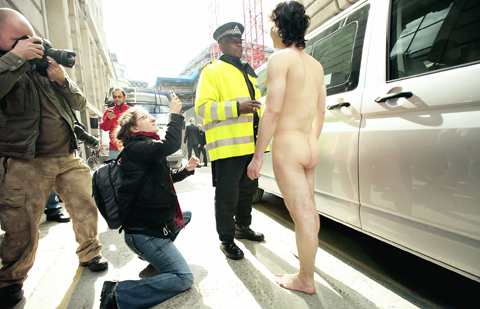Police said yesterday they made 86 arrests during the lengthy violent protests that besieged central London’s financial district ahead of the G20 summit.
Thousands of people demonstrated on the streets of London on Wednesday in angry demonstrations that descended into violent battles with riot police and saw one man collapse and die.
Protesters were set to take to the streets again yesterday, this time close to the ExCeL exhibition center in east London’s Docklands, where the summit was taking place.

PHOTO: AFP
Some protesters smashed their way into the offices of the state-owned Royal Bank of Scotland (RBS) next to the Bank of England on Wednesday, breaking through windows, hurling out office equipment and trying to set it ablaze.
The 86 arrests were for a range of offenses, including violent disorder, aggravated burglary, arson, bomb threats and possession of ammunition.
Four people have been charged with offenses so far, three with possessing a bladed weapon and one with assault.
Police said that about 4,000 protesters had converged on the City of London financial district.
Riot police penned in the protesters and let them out one by one. Some were still being dispersed early yesterday, more than 12 hours after the demonstration began.
Expecting demonstrations and disorder, police launched a massive security operation to keep protesters at bay.
Up to 4,700 police officers, including public order teams, intelligence gatherers and diplomatic security specialists were to be on duty yesterday in the British capital.
The London Stock Exchange opened without incident despite threats from protesters. Police officers circled the entrance to the building.
On Wednesday, riot police staged baton charges to try to disperse several hundred people protesting against a financial system they said had robbed the poor to benefit the rich. At one stage, about 4,000 protesters had thronged outside the central bank.
Rescued by the government in October, RBS and former boss Fred Goodwin, who controversially refused to give up a pension of £700,000 (US$1 million), became lightning rods for public anger in the UK over banker excess blamed for the financial crisis.
During the protests one man died after he collapsed and stopped breathing. Police said they tried to resuscitate him but that they came under a hail of bottles. The man was taken by ambulance to a nearby hospital where he was pronounced dead.
A police source said it was likely the man died from a medical condition but that a post-mortem was needed.
The protests in London’s City financial area coincided with a G20 meeting of the world’s leading and emerging economies.
Protesters hurled paint bombs and bottles, chanting: “Our streets! Our banks!”
RBS said in a statement it was “aware of the violence” outside its branch and “had already taken the precautionary step” of closing central City branches.
As dusk fell, police charged a hard core of anti-capitalist demonstrators in an attempt to disperse them before nightfall. Bottles flew through the air towards police lines and police on horseback stood by ready to intervene.
Some protesters set fire to an effigy of a banker hanging from a lamp post.
Police brought out dogs as they tried to channel the few hundred remaining protesters through the narrow streets surrounding the classical, stone-clad Bank of England.
Some shops had boarded up their windows in case of violence. A Gucci store near the Bank of England was closed and had emptied its windows.
During Wednesday’s protests, demonstrators marched behind models of the “four horsemen of the apocalypse” representing financial crimes, war, climate change and homelessness.
Some threw eggs at police and chanted, “Build a bonfire, put the bankers on the top.” Others shouted “Jump” and “Shame on you” at financial sector workers watching the march from office block windows.
“I am angry at the hubris of the government, the hubris of the bankers,” said Jean Noble, a 60-year-old from Blackburn in northern England. “I am here on behalf of the poor, those who are not going to now get their pension or who have lost their houses while these fat cats keep their bonuses, hide their money in tax havens and go and live where nobody can touch them.”

BACKLASH: The National Party quit its decades-long partnership with the Liberal Party after their election loss to center-left Labor, which won a historic third term Australia’s National Party has split from its conservative coalition partner of more than 60 years, the Liberal Party, citing policy differences over renewable energy and after a resounding loss at a national election this month. “Its time to have a break,” Nationals leader David Littleproud told reporters yesterday. The split shows the pressure on Australia’s conservative parties after Prime Minister Anthony Albanese’s center-left Labor party won a historic second term in the May 3 election, powered by a voter backlash against US President Donald Trump’s policies. Under the long-standing partnership in state and federal politics, the Liberal and National coalition had shared power

CONTROVERSY: During the performance of Israel’s entrant Yuval Raphael’s song ‘New Day Will Rise,’ loud whistles were heard and two people tried to get on stage Austria’s JJ yesterday won the Eurovision Song Contest, with his operatic song Wasted Love triumphing at the world’s biggest live music television event. After votes from national juries around Europe and viewers from across the continent and beyond, JJ gave Austria its first victory since bearded drag performer Conchita Wurst’s 2014 triumph. After the nail-biting drama as the votes were revealed running into yesterday morning, Austria finished with 436 points, ahead of Israel — whose participation drew protests — on 357 and Estonia on 356. “Thank you to you, Europe, for making my dreams come true,” 24-year-old countertenor JJ, whose

A documentary whose main subject, 25-year-old photojournalist Fatima Hassouna, was killed in an Israeli airstrike in Gaza weeks before it premiered at Cannes stunned viewers into silence at the festival on Thursday. As the cinema lights came back on, filmmaker Sepideh Farsi held up an image of the young Palestinian woman killed with younger siblings on April 16, and encouraged the audience to stand up and clap to pay tribute. “To kill a child, to kill a photographer is unacceptable,” Farsi said. “There are still children to save. It must be done fast,” the exiled Iranian filmmaker added. With Israel

Africa has established the continent’s first space agency to boost Earth observation and data sharing at a time when a more hostile global context is limiting the availability of climate and weather information. The African Space Agency opened its doors last month under the umbrella of the African Union and is headquartered in Cairo. The new organization, which is still being set up and hiring people in key positions, is to coordinate existing national space programs. It aims to improve the continent’s space infrastructure by launching satellites, setting up weather stations and making sure data can be shared across